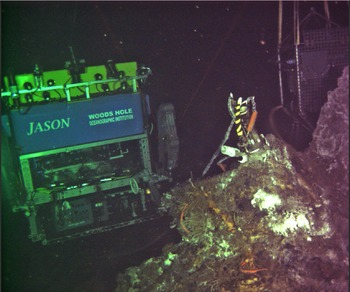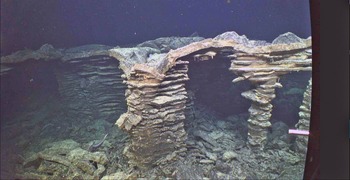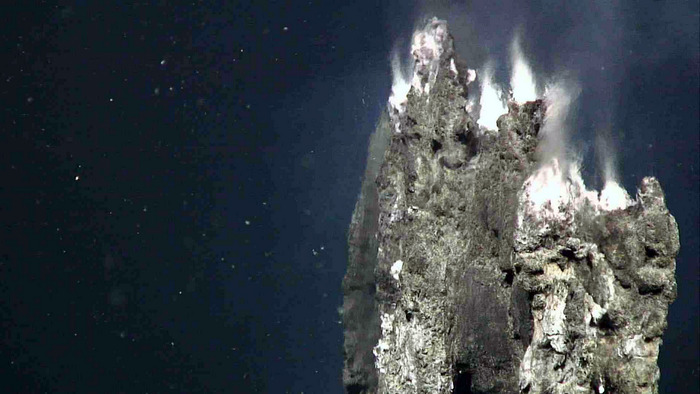"the complete darkness of the nearly mile deep waters was lit by the lights of the cabled digital still camera controlled from land over 500 km away: Lights on – MAGIC, “Jason – we see you live from land”!

Jason gets a live portrait taken while diving in the International District Hydrothermal Field by the Regional Cabled Array digital still camera. The lights on the ROV were turned off, and APL engineers in the UW Operations turned the camera on from onshore, >500 km away. Credit: UW/OOI-NSF, V17.

Columns in a collapsed area that once hosted a lava lake are reminiscent of an ancient city. "Bathtub" rings mark lowering of the lake as lava drained out. Fossilized drips of lava are preserved hanging from the ceiling. A rattail fish explores the site. This is part of the 2011 eruption at Axial. Credit: UW/OO-NSF/WHOI; J2-980; V17.
The weather at Axial Seamount continues to be stellar for Jason dives. In the wee hours of yesterday morning, James Tilley, an APL engineer who was a key developer of the Cabled Array junction boxes, lead the dive to 2700 m to turn the junction box at the base of Axial Seamount. At ~ 2700 m water depth it takes about 1.5 hours for Jason to reach the bottom. Here, instead of the glassy, lava-covered seascape that characterizes the summit of Axial Seamount, the seafloor is covered in thick sediment. As the vehicle descended through the top surface waters, the sea was alive with pyrosomes. These colonial animals have infiltrated the NE Pacific waters by the millions. Having worked in these waters for >30 years, we have never seen such an infestation of these animals.
Their names come from the Greek words “pyro” meaning fire and “soma” means body. They lived up to their name at Axial Base, easily viewed in the dark waters adjacent to the ship. At Axial, each colonial animal that we saw was less than a foot in length, but in some parts of the oceans they can reach to 60 ft. The third mate on the R/V Revelle called down to the main lab to let us know there was a large “swarm” of pyrosomes along side the ship. Researchers at Oregon State University have asked us to collect a few of these animals as we transit across the Juan de Fuca Plate, sampling the animals from near-shore to far off-shore “blue” water environments such as Axial Seamount. We used a net to bring a couple of the pyrosomes onboard. We were surprised at how hard/plastic-like their bodies were, thinking that they would be more like sea cucumbers in texture as we watched them undulate in the ocean. They have numerous small “knobs” with small red patches distributed throughout the length of their bodies and a hollow central tube – these animals are bioluminescent and eat plankton. It is interesting to think about what impact this infestation is having on the NE Pacific ecosystem.
Yesterday was a fantastic day – after we finished work at Axial Base, the R/V Revelle transited about 1 hr to the northwest to the summit of Axial Seamount. Jason dove to 1500 m into the International District Hydrothermal Field that hosts black smoker chimneys reaching temperatures of 350°C – El Guapo (the ‘handsome one), El Gordo (the fat one), Escargot (snail) are some of our “friends” that inhabit this amazing place. During the dive, we investigated a site, “Tiny Towers,” as a possible new sit to install the digital still camera, mass spectrometer, and fluid and DNA sampler that are now at El Gordo. This steep-sided structure is difficult to work at, while Tiny Towers has gentler relief. We measured a temperature of 82°C, well within the range for the fluid sampling and analytical instruments. At El Gordo, Ben, the Jason pilot on watch, turned the lights off on the vehicle – the complete darkness of the nearly mile deep waters was lit by the lights of the cabled digital still camera controlled from land over 500 km away by APL engineers in the UW Operations Center: Lights on – MAGIC, “Jason – we see you live from land”!
During the dive, we also looked at El Guapo, which is the largest chimney in the field rising >18 m above the seafloor. The top is always a sight to behold – fluids jetting from the small actively venting spigots at the top of the structure are reminiscent of flames. These fluids are boiling. Following this, we took a short tour of the 2011 eruption to the southwest, following lava channels from the 2011 eruption, huge collapse zones with columns and arches reminiscent of abandoned ancient cities, and frozen lava lakes with whirlpools and chaotic terrane as the once 2000°F rivers of lava flowed adjacent to channel walls. The dive ended at Skadi’s Cauldron, which in 2011 was a spectacular snow blower. Here, in 2011, billions of microbes issued from the seafloor supported by warm, carbon dioxide-rich fluids that created these subsurface blooms. Although the snowblowers are gone, diffuse venting still issues from this site, now marked by healthy tube worm bushes. Deep within the collapse zone, there are small patches of microbial mats with gray, very small snails and a few clams.
It was a remarkable dive – the students filled the control van, silently watching in awe a place few eyes have ever seen!


